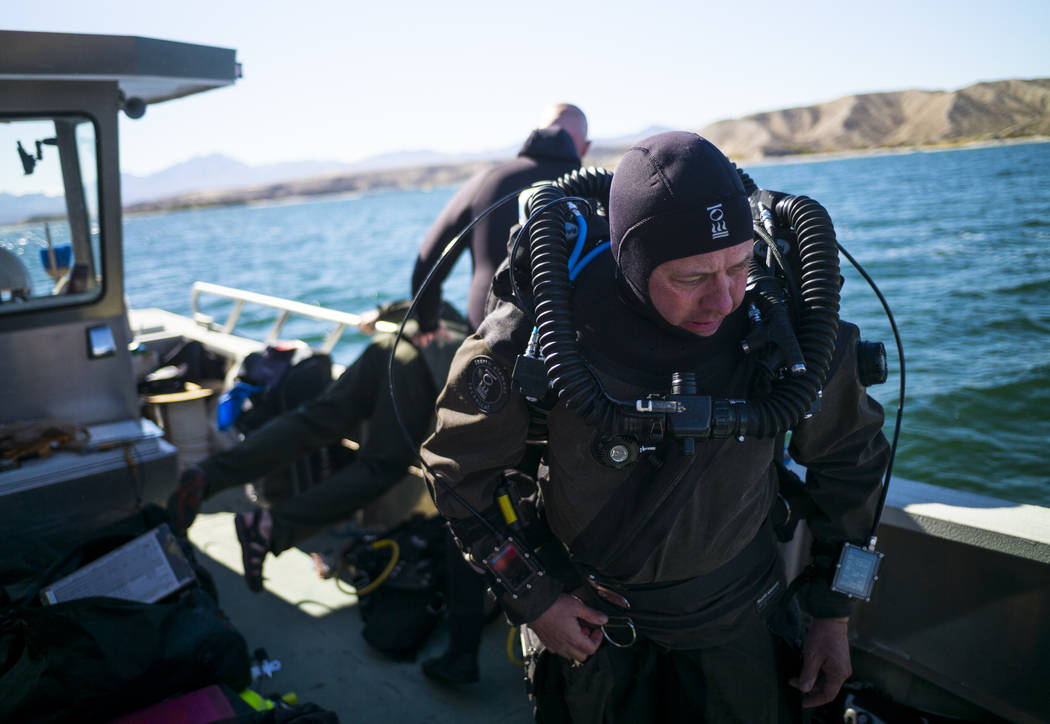Wounded veterans dive for history, healing in waters of Lake Mohave

Jeff Pickard has lived with constant pain in his left arm and hand since an Iraqi sniper shot him in the shoulder in 2010.
“It’s like a bunch of needles being punched into my arm all the time,” said the medically retired Army and Navy veteran from Temecula, California.
The pain medicine he takes doesn’t blunt the sensation. The only thing that brings him relief is scuba diving.
Pickard said the more time he spends below about 50 feet, the less his arm hurts in the hours and days afterward.
Something about “the squeeze” quiets his scrambled nerves, sometimes for as much as a week at a time, he said as he stood in his wetsuit Wednesday on the deck of a houseboat on Lake Mohave.
Pickard is a divemaster-in-training for WAVES, short for Wounded American Veterans Experience Scuba, a California-based nonprofit that provides dive training to vets with service-connected injuries or disabilities.
Seven members of the group spent the week at Lake Mead National Recreation Area, diving down to historic sites alongside a team from the National Park Service’s Submerged Resources Center. It was the first outing in a new partnership between WAVES and the park service that will train wounded warriors to become scuba stewards for underwater resources at the nation’s parks.
A mission that heals
Dave Conlin, chief of the Submerged Resources Center, loves everything about the partnership. He said he and his team “get to hang out with a great group of guys” and give a little something back to wounded veterans, “which in and of itself is the very least we can do.”
In return, the park service is getting a new crop of trained volunteers to help the small, largely overworked dive teams at various sites. Lake Mead National Recreation Area, for example, has hundreds of square miles of open water and just three divers on staff.
“It’s been really moving to see the way everyone has rallied together to make this happen,” Conlin said.
So what do WAVES members get out the deal?
“A mission that gets them in the water more,” said Steve Rubin, founder and president of the organization. “They’re having fun, so they don’t realize they’ve just undergone therapy.”
On Tuesday, the group dived down about 60 feet to inspect some metal leaching tanks left over from a gold mining operation that probably dates to the late 1800s.
Wednesday’s dive took them down as much as 90 feet to the remnants of an aerial ferry that carried cars, equipment and livestock across the Colorado River from 1930 to 1935. Today the site is strewn with steel cable and the towers that once held them aloft above the river. The ferry carriage rests relatively intact at the bottom of the lake, near the old river channel.
More diving in Lake Mohave was planned for Thursday.
For all but one in the WAVES group, these were their first dives in a freshwater lake, an experience Rubin said can be darker and more eerie than ocean diving.
“It’s like being on another planet,” Pickard said.
Diving for calm
Rubin said WAVES grew out of an effort to help his friend’s son-in-law, a Marine named John Schumacher who lost his legs and several of his fingers to a roadside bomb in Afghanistan.
In 2012, Schumacher expressed an interest in scuba diving, so Rubin agreed to be his diving instructor if he agreed to be Rubin’s guinea pig.
The two learned about diving with disabilities together. The benefits were apparent almost immediately.
“Once you become neutrally buoyant, there’s no disability. You’re an able-bodied diver just like anyone else,” Rubin said.
Within a year of that first dive, Rubin had formed a nonprofit in California to get more wounded warriors into the water.
The immersive experience also proved to be therapeutic for veterans dealing with the effects of post-traumatic stress disorder.
“It has a calming effect. It burns the energy that is stored in the body,” Rubin said. “We’ll get calls from their wives saying, ‘Get them in the water.’”
WAVES provides all the equipment and training for a veteran and a “dive buddy” to become scuba certified free of charge. Rubin said some vets chose to go through the program with their spouses, while others bring their kids or learn to dive with friends they served with.
“That’s part of the therapy, too: The camaraderie,” Rubin said.
Returning the favor
So far, 200 wounded veterans and their “dive buddies” have earned certification through WAVES, which now boasts partnerships with veteran-owned dive shops in several states.
Several program participants, Pickard included, have chosen to stay on and earn higher certifications so they can train others.
Pickard said his wife is also his licensed caregiver, and she’s the one who discovered WAVES and encouraged him to sign up. The 44-year-old father of five took his first dive with the group about a year ago in the Pacific off Catalina Island.
“I saw a sea bass that was bigger than you,” he recalled.
Since then, Pickard has trained as a rescue diver and a divemaster, and he hopes to become a full-fledged scuba instructor.
“I want to be able to explain it better, to explain the experience,” he said, his wetsuit still dripping water. “I just want to give back.”
Contact Henry Brean at hbrean@reviewjournal.com or 702-383-0350. Follow @RefriedBrean on Twitter.